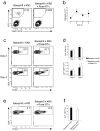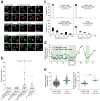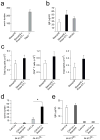Genetic analysis of basophil function in vivo
- PMID: 21552267
- PMCID: PMC3271435
- DOI: 10.1038/ni.2036
Genetic analysis of basophil function in vivo
Erratum in
- Nat Immunol. 2011 Jun;12(6):3 p following 535
Abstract
Contributions by basophils to allergic and helminth immunity remain incompletely defined. Using sensitive interleukin 4 (Il4) reporter alleles, we demonstrate here that basophil IL-4 production occurs by a CD4(+) T cell-dependent process restricted to the peripheral tissues affected. We genetically marked and achieved specific deletion of basophils and found that basophils did not mediate T helper type 2 (T(H)2) priming in vivo. Two-photon imaging confirmed that basophils did not interact with antigen-specific T cells in lymph nodes but engaged in prolonged serial interactions with T cells in lung tissues. Although targeted deletion of IL-4 and IL-13 in either CD4(+) T cells or basophils had a minimal effect on worm clearance, deletion from both lineages demonstrated a nonredundant role for basophil cytokines in primary helminth immunity.
Conflict of interest statement
The authors declare no competing financial interests.
Figures






Similar articles
-
Basophil-mediated protection against gastrointestinal helminths requires IgE-induced cytokine secretion.Proc Natl Acad Sci U S A. 2014 Dec 2;111(48):E5169-77. doi: 10.1073/pnas.1412663111. Epub 2014 Nov 17. Proc Natl Acad Sci U S A. 2014. PMID: 25404305 Free PMC article.
-
Impaired basophil induction leads to an age-dependent innate defect in type 2 immunity during helminth infection in mice.J Immunol. 2011 Apr 15;186(8):4631-9. doi: 10.4049/jimmunol.1002995. Epub 2011 Mar 11. J Immunol. 2011. PMID: 21398616
-
Basophils are the major producers of IL-4 during primary helminth infection.J Immunol. 2011 Mar 1;186(5):2719-28. doi: 10.4049/jimmunol.1000940. Epub 2011 Jan 26. J Immunol. 2011. PMID: 21270410 Free PMC article.
-
Recent developments in basophil research: do basophils initiate and perpetuate type 2 T-helper cell responses?Int Arch Allergy Immunol. 2013;160(1):7-17. doi: 10.1159/000341633. Epub 2012 Aug 30. Int Arch Allergy Immunol. 2013. PMID: 22948001 Review.
-
Basophils are potent antigen-presenting cells that selectively induce Th2 cells.Eur J Immunol. 2010 Jul;40(7):1836-42. doi: 10.1002/eji.201040588. Eur J Immunol. 2010. PMID: 20518033 Review.
Cited by
-
Basophils promote barrier dysfunction and resolution in the atopic skin.J Allergy Clin Immunol. 2021 Sep;148(3):799-812.e10. doi: 10.1016/j.jaci.2021.02.018. Epub 2021 Mar 2. J Allergy Clin Immunol. 2021. PMID: 33662369 Free PMC article.
-
A Crystallin Fold in the Interleukin-4-inducing Principle of Schistosoma mansoni Eggs (IPSE/α-1) Mediates IgE Binding for Antigen-independent Basophil Activation.J Biol Chem. 2015 Sep 4;290(36):22111-26. doi: 10.1074/jbc.M115.675066. Epub 2015 Jul 10. J Biol Chem. 2015. PMID: 26163514 Free PMC article.
-
The Transcription Factor PLZF Is Necessary for the Development and Function of Mouse Basophils.J Immunol. 2019 Sep 1;203(5):1230-1241. doi: 10.4049/jimmunol.1900068. Epub 2019 Jul 31. J Immunol. 2019. PMID: 31366712 Free PMC article.
-
Helminth-induced interleukin-4 abrogates invariant natural killer T cell activation-associated clearance of bacterial infection.Infect Immun. 2014 May;82(5):2087-97. doi: 10.1128/IAI.01578-13. Epub 2014 Mar 18. Infect Immun. 2014. PMID: 24643536 Free PMC article.
-
The skin is an important bulwark of acquired immunity against intestinal helminths.J Exp Med. 2013 Nov 18;210(12):2583-95. doi: 10.1084/jem.20130761. Epub 2013 Oct 28. J Exp Med. 2013. PMID: 24166714 Free PMC article.
References
-
- Chan MS. The global burden of intestinal nematode infections--fifty years on. Parasitol Today. 1997;13:438–443. - PubMed
-
- Urban JF, Jr, Maliszewski CR, Madden KB, Katona IM, Finkelman FD. IL-4 treatment can cure established gastrointestinal nematode infections in immunocompetent and immunodeficient mice. J Immunol. 1995;154:4675–4684. - PubMed
-
- Urban JF, Jr, et al. IL-13, IL-4Ralpha, and Stat6 are required for the expulsion of the gastrointestinal nematode parasite Nippostrongylus brasiliensis. Immunity. 1998;8:255–264. - PubMed
Publication types
MeSH terms
Substances
Grants and funding
LinkOut - more resources
Full Text Sources
Other Literature Sources
Molecular Biology Databases
Research Materials

